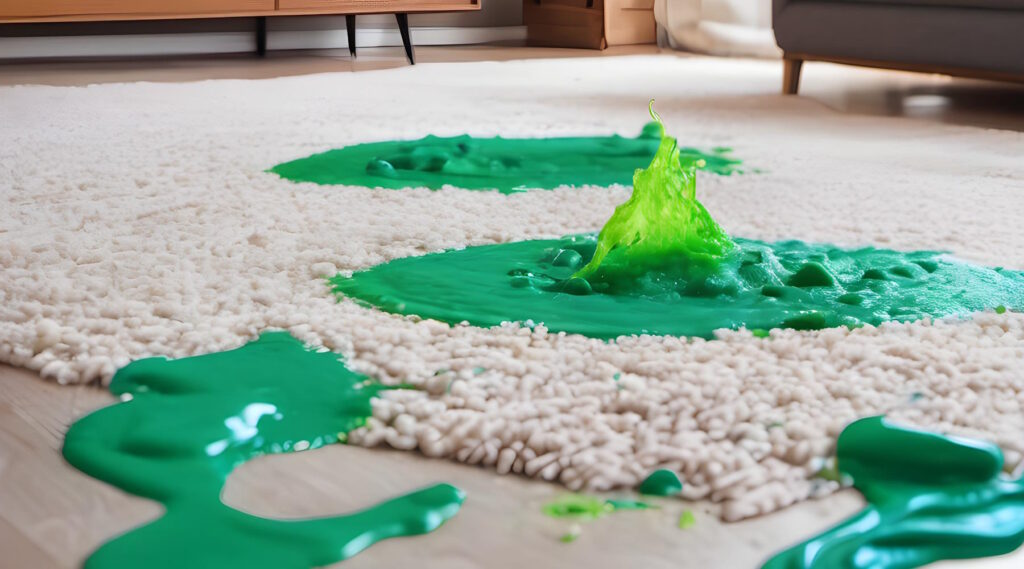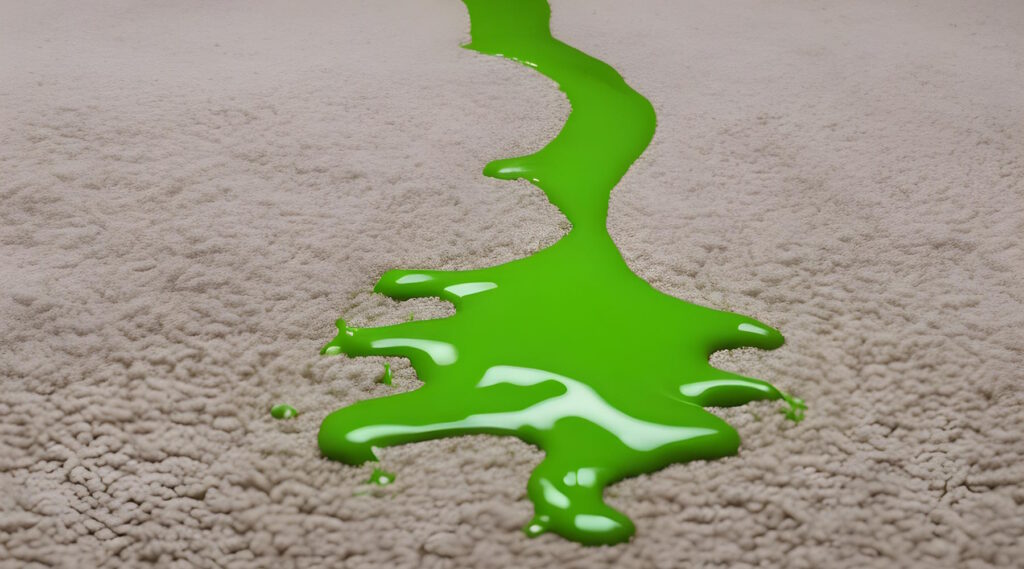How To Get Dried Slime Out Of Your Carpet

Looking for more information on how to get dried slime out of your carpet? Getting slime out of carpet can be a challenging task, often leaving homeowners puzzled. Slime, the gooey and stretchy plaything loved by children, unfortunately doesn’t discriminate where it ends up. Whether during an enthusiastic play session or accidental spill, slime can quickly work its way into the fibers of a carpet, leaving a stubborn stain that isn’t easily tackled with conventional cleaning methods.
When confronted with a slime stain in your carpet, the approach to removal is key to maintaining the integrity of the carpet. It’s essential to remove as much of the slime as possible before attempting to clean the area. This preliminary step can involve gently scraping away the slime with a spoon or a similar blunt tool. After most of the physical substance has been removed, specific cleaning solutions and techniques can be applied to dissolve and lift away any remaining residue.
A step-by-step method is advisable for effectively cleaning slime from carpets. One can start by using household items such as vinegar, warm water, and dish soap, which can break down the slime’s composition. It is beneficial to treat the affected area promptly to prevent the slime from drying and further embedding into the carpet fibers. In some cases, a vacuum cleaner can be used to remove dried bits of slime post-treatment. However, care must be taken as to not damage the carpet pile. Stain removal from carpets requires patience and a careful, methodical approach to ensure the carpet is left clean, without residue, and undamaged.

Slime in carpet
Immediate Actions for Slime Removal
When dealing with slime on carpet, one must act quickly and efficiently. The key is to address the spill with proper techniques to prevent the slime from setting into the fibers.
Removing Wet Slime
The best time to clean slime is when it’s still wet. First, use paper towels to gently blot and lift as much slime as possible, avoiding rubbing which can push it deeper into the carpet. Next, apply ice cubes directly onto remaining slime to harden it. Once it’s solidified, scrape off excess with a butter knife. Be careful not to damage the carpet fibers.
| Step | Action |
|---|---|
| 1 | Blot with paper towels |
| 2 | Harden with ice cubes |
| 3 | Scrape with a butter knife |
Handling Dried Slime
For dried slime, one must first break it down. Vacuum over the area to remove any loose particles. Then, moisten the dried slime with warm water to soften it. Using a butter knife, gently work underneath the slime to detach it from the carpet fibers. Repeat the steps as necessary until the slime is fully removed.
- Vacuum any loose particles
- Moisten with warm water
- Scrape gently with a butter knife
Cleaning Solutions for Slime
Removing slime from carpets requires a careful approach to avoid damage. Effective solutions range from simple pantry items to specialized cleaning products.
Vinegar-Based Solutions
A mixture of vinegar and warm water can be an effective solution for removing slime. The acidity of vinegar helps break down the slime, making it easier to clean:
- Ingredients: 2 parts warm water, 1 part white vinegar.
- Method: Blot the stain, apply the vinegar solution, gently scrub, rinse with water, and pat dry.
Detergent and Water Mix
For those concerned about vinegar’s smell, a mild dish soap and water solution is an alternative:
- Ingredients: Warm water, several drops of dish soap.
- Method: Mix, apply to the affected area, and use a scrubbing brush in a gentle motion. Rinse and dry afterward.
Alternate Home Remedies
Several household items can be useful in removing slime stains:
- Baking Soda & Vinegar: Sprinkle baking soda, add vinegar, wait for the fizzing to stop, then scrub and rinse.
- Club Soda: The carbonation can help lift slime. Pour, let it sit, then blot and rinse.
- Citrus Solvent: A natural alternative to remove slime without harsh chemicals.
Using these solutions appropriately will result in a cleaner carpet, free of slime.
Techniques and Tools for Scraping and Blotting
Removing slime from carpet requires a careful balance of scraping to lift the substance and blotting to absorb it. Effective use of the right tools and techniques is crucial in preventing damage to the fibers.
Scraping Tools
When it comes to the removal of slime, one should begin with gentle scraping. Plastic scrapers or the edge of a credit card can be utilized to lift as much slime as possible without further embedding it into the carpet. It’s imperative to scrape from the outside toward the center to restrict the slime’s spread.
- Plastic knife or spoon: Minimally abrasive and suitable for initial lifting.
- Credit card: Sturdy and flat, effective for getting under the slime.
Blotting Methods
After scraping, the next step is to blot the affected area. This technique involves applying pressure to absorb moisture without rubbing the slime deeper into the carpet. The blotting process works best with an absorbent material.
- Paper towels: Layers of paper towels can be pressed onto the slime to soak it up.
- Clean cloth or kitchen towel: These reusable options are effective for absorbing liquids.
- Sponge: A damp sponge can be used in combination with a cleaning agent to dab at the slime gently.
For stubborn slime remnants, a blend of baking soda and vinegar can be applied to dissolve the substance before blotting. One should allow the mixture to bubble on the slime, then carefully blot the area with a towel. The reaction between the baking soda and vinegar helps to break down the slime, making it easier to lift from the carpet fibers.
Thorough Cleaning Post Slime Removal
After successfully removing slime from the carpet, thorough cleaning ensures the complete restoration of the carpet’s look and hygiene. The following measures are fundamental to sustaining the carpet’s cleanliness.
Vacuuming Carpet Fibers
Vacuuming is pivotal for picking up residual particles that cling to the carpet fibers after slime removal. A vacuum cleaner with strong suction is recommended to effectively extract any leftover slime bits. Subsequent to a vacuuming session, carpet fibers often regain much of their natural texture.
| Vacuuming Steps | Description |
|---|---|
| Step 1: Inspection | Inspect the carpet for any missed slime residues. |
| Step 2: Preparation | Set the vacuum cleaner to a proper height setting to match the carpet pile. |
| Step 3: Systematic Cleaning | Vacuum in overlapping strokes, slow and steady, to ensure all areas are covered. |
Consider a Professional Carpet Cleaner
Opting for a professional carpet cleaner to tackle play slime in your carpets is a smart move for several reasons. Professionals bring a level of expertise and experience that’s unmatched by DIY methods, understanding the intricacies of slime removal and employing specialized equipment and cleaning solutions that are far superior to standard household cleaners. This not only ensures a deeper and more effective clean but also saves you significant time and effort, allowing you to focus on other priorities without the hassle of dealing with stubborn stains.
Moreover, the risk of damaging your carpets through incorrect cleaning methods is eliminated when you entrust the job to experts. They know precisely how to remove stains without harming the carpet fibers, thereby preserving the appearance and extending the lifespan of your carpets. Additionally, a professional clean doesn’t just remove the visible mess but also sanitizes the area, improving the health and hygiene of your indoor environment. Considering these benefits, the investment in professional carpet cleaning services proves cost-effective in the long run, offering guaranteed results and peace of mind that DIY methods simply can’t match.
Preventing and Minimizing Future Slime Stains
Taking proactive steps greatly reduces the risk of stubborn slime stains on the carpet. It helps preserve the carpet’s texture and appearance.
Protective Measures
One can prevent most stains by setting clear boundaries for where slime can be used, specifically designating play areas that are not carpeted. However, if one must use slime on carpeted surfaces, the following measures are advisable:
- Use of Plastic Tarps or Washable Mats: Place them beneath the play area to act as a barrier between the slime and the carpet.
- Furniture Covers: Employ furniture covers or old sheets to avoid slime contact with fabric and carpet backing.
- Clothing Consideration: Encourage the use of old clothes during play, as slime can easily transfer from fabric to carpet.
Immediate Cleanup Is Key
Swift action is crucial to prevent the slime from seeping into the carpet fibers and backing. If slime comes into contact with the carpet:
- Quick Response: Remove as much slime as possible by gently scraping it off the carpet surface.
- Avoid Rubbing: Pat the affected area with water or a cleaning solution instead of rubbing, to minimize the stain’s spread.
Consistency in these practices will significantly reduce the likelihood of future slime stains, making upkeep simpler and preserving the carpet’s integrity.
Additional Tips and Advice
- Patience: Patience is crucial when removing slime from carpet fibers. Rushing the process can embed the slime deeper into the material.
- Gloves: Wearing gloves is advisable to keep hands protected and clean when working with cleaning solutions.
- Air Dry: After cleaning, allow the carpet to air dry completely. This helps to avoid any mold or mildew growth from residual moisture.
- Laundry Detergent: Use a small amount of laundry detergent on the affected area. This can help break down the slime’s composition.
- Homemade Slime: If the slime is homemade, understanding its ingredients can inform the best cleaning method.
- Household Items:
- Vinegar can break down the slime and is often safe for carpets.
- Rubbing alcohol can be effective but should be spot tested first.
- Food Coloring Stains: For slime with food coloring, extra care is needed to avoid staining. A mixture of vinegar and warm water can aid in removing color.
- Protect Clothing: It’s wise to wear old clothing when cleaning. Cleaning solutions or the slime itself may stain fabrics.
By incorporating these practices, individuals can effectively remove slime from carpeted surfaces while preserving the carpet’s integrity.
Recapping How To Get Dried Slime Out Of Your Carpet
Removing slime from carpets can be managed efficiently with the right approach. The key is to act promptly and follow a step-by-step process to prevent the stain from setting. Individuals can tackle slime removal with common household items, demonstrating that often no specialized equipment is necessary.
| Step | Tips |
|---|---|
| 1. Scrape Off | Gently remove excess slime without rubbing it deeper into the fibers. |
| 2. Vinegar Solution | Apply a solution of vinegar and water to break down the slime’s stickiness. |
| 3. Blotting | Pat the area with a clean cloth to lift the slime from the carpet. |
| 4. Final Clean | Use soapy water for a final wash, then rinse and let dry. |
To maintain carpets post-slime incident, regular vacuuming and immediate attention to new stains are recommended. This proactive approach will make future cleaning tasks less daunting and ensure that carpets remain clean and visually appealing.
By adhering to these instructions, individuals can efficiently address the challenge of slime encounters in their domestic environment. Need help? Reach out to J.G. Carpet Cleaning today!
